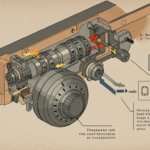Choosing the right garage door size is crucial for both functionality and aesthetics. A garage door should seamlessly fit into your home’s design while serving the practical needs of your lifestyle. With various dimensions and styles available, making an informed decision that aligns with your daily routines and future needs is essential. We will explore several factors influencing garage door sizes standard selection, including vehicle dimensions, space utilization, and aesthetic considerations, to help you choose the most suitable option for your home.
Assessing Your Vehicle Needs
The size of your vehicle plays a significant role in determining the optimal garage door dimensions. Standard single-car garage doors typically measure around 7 feet high by 9 to 10 feet wide, accommodating most average-sized cars. However, if you own larger vehicles such as SUVs, trucks, or vans, opting for a wider door is necessary to ensure easy access. Double-car garage doors usually measure 14 feet wide by 7 feet high, offering ample space for two side-by-side vehicles. Additionally, for those with oversized or custom vehicles, a taller door height or even a custom-sized door may be required. By accurately measuring your vehicles and considering future acquisitions, you can select a door size that prevents potential inconvenience and ensures smooth operation.
Maximizing Space Efficiency
Efficient use of space is another critical aspect when determining the garage door size. A garage door that fits well with the dimensions of your garage can help optimize space management. A single-door configuration might be ideal for smaller garages, while more oversized garages may benefit from a double-door or three-door setup. Additionally, consider the internal layout of the garage. A larger door can provide easier access and better functionality if you plan to use the garage for more than just vehicle storage, such as for workshops, storage, or recreational activities. Ensure enough clearance on either side of the door to accommodate opening and closing mechanisms without obstructing other areas. Properly sizing your garage door about the internal space can enhance usability and comfort.
Considering Aesthetic Harmony
The garage door’s appearance can significantly impact the overall curb appeal of your home. When selecting a door size, it is essential to consider how it complements the architectural style of your house. A door that is too small or oversized can disrupt the visual balance of your home’s exterior. A classic single or double-door design may blend seamlessly with traditional homes, while contemporary homes might benefit from more expansive and sleek door options. Custom designs and materials are also available to match specific architectural elements and personal preferences. The goal is to achieve a harmonious look that enhances functionality and aesthetics. Ensure the garage door size aligns with your home’s design and contributes positively to its overall appearance.
Evaluating Future Needs
Anticipating future changes in your lifestyle can influence your decision on garage door size. If you plan to upgrade your vehicles or modify the garage’s use over time, opting for a larger door than is currently necessary might be a wise choice. This forward-thinking approach can save you from the hassle and expense of replacing the door later. Consider potential uses for the garage, such as utilizing garage storage Vancouver services, creating a workshop, or transforming the space into a multifunctional area. By planning for future needs, you ensure that the garage door will continue to meet your requirements effectively and contribute to the long-term usability of your garage.
Understanding Local Regulations
Before finalizing your garage door size, you must know local building codes and regulations. Different regions may have specific requirements or restrictions related to garage door dimensions, especially if you live in a community with a homeowners association. Local regulations dictate minimum or maximum sizes and design and material standards. Ensuring compliance with these regulations helps avoid potential issues with permits and inspections. Additionally, adhering to local standards can ensure that your garage door installation meets community expectations and safety requirements.
Evaluating Installation and Maintenance
The installation and ongoing maintenance of the garage door are also influenced by its size. Larger doors require more robust installation techniques and additional support structures, which could impact the overall cost and complexity of the installation process. Additionally, maintenance requirements can vary based on door size and type. Larger doors may demand frequent servicing or specialized attention to ensure smooth operation. It’s advisable to consult with professionals to understand the installation and maintenance needs associated with different door sizes. Ensuring that your chosen door can be adequately supported and maintained will contribute to its longevity and performance.
Selecting the optimal garage door size involves considering various factors, including vehicle dimensions, space efficiency, aesthetic harmony, future needs, local regulations, and installation requirements. By taking these aspects into account, you can make an informed decision that enhances your garage’s functionality and appearance. We have explored how assessing your needs and preferences plays a crucial role in choosing the right size for your garage door. Ultimately, a well-chosen garage door complements your home’s design and efficiently serves your practical requirements.











